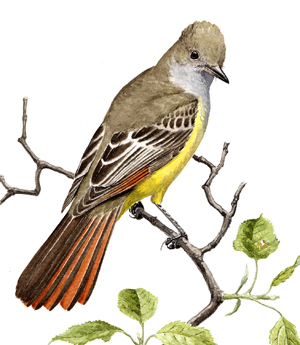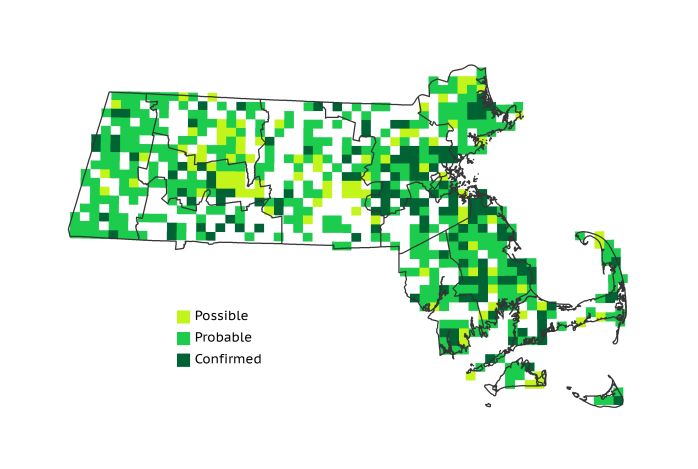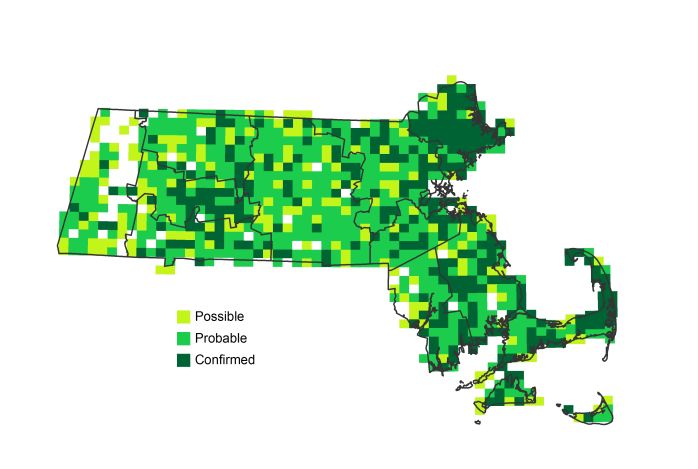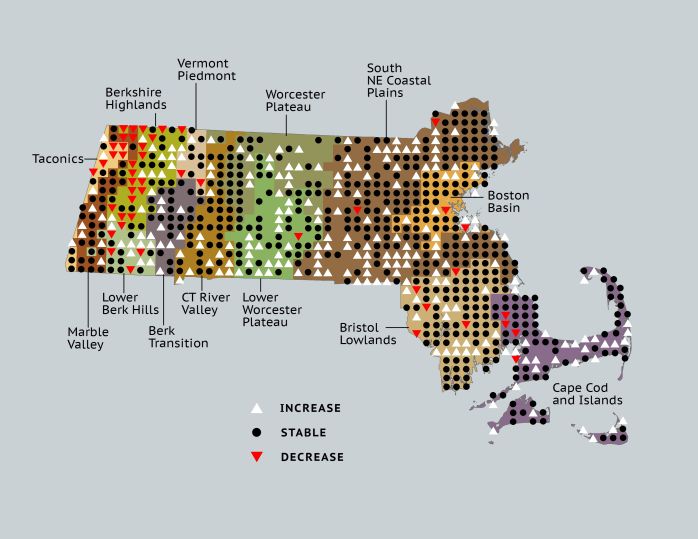Breeding Bird Atlases (BBA)
Find a Bird
Great Crested Flycatcher
Myiarchus crinitus

Nearly ubiquitous and likely increasing
“The wild Irishman of them all is the Great Crested Flycatcher, a large, leather-coloured or sandy complexioned bird, that prowls through the woods, uttering its harsh, uncanny note, and waging fierce warfare upon its fellows.” – John Burroughs, Birds and Poets
Open deciduous forests across Massachusetts resound in late spring with the loud wheep! calls of the Great Crested Flycatcher that sound as if they came from an old-fashioned police whistle. This species was likely rare in the Bay State while farmland still dominated the countryside, but it prospered as Massachusetts forests regenerated. Forest fragmentation, a prevalent phenomenon in Massachusetts today, creates ideal breeding conditions for the Great Crested Flycatcher. Unique among Massachusetts flycatchers, this species nests in tree cavities rather than on ledges or on tree limbs.
Historic Status
Unmistakably and forever tied to its nesting needs, the Great Crested Flycatcher was described by Peabody in 1839 as “not numerous enough at present to be of much importance” in Massachusetts (Peabody 1839). Deciduous forests returned to Massachusetts as farmland was abandoned in the late 1800s, and the Great Crested Flycatcher population increased along with the attendant habitat regeneration. Forbush noted in the 1920s that the species specifically did not need large patches of forest, but only large enough trees in which to support its nests (Forbush 1927). He found Great Crested Flycatchers nesting in old orchard trees on otherwise open landscapes, areas that provided cultivated yet suitable substitutes for nesting (Forbush 1927). From the 1920s to the 1960s, the species gradually went from an uncommon breeder to a widely distributed bird on the Massachusetts landscape.
Atlas 1 Distribution
By the time of Atlas 1, Great Crested Flycatchers had become widespread. Block occupancy figures consistently hovered in the 50% to 70% range in most ecoregions across the state, with only a few deviations. The Taconic Mountains had 75% block occupancy; the Marble Valleys region, with its natural matrix of forests laced with ridges and rivers, provided excellent habitat for Great Crested Flycatchers, and achieved 77% occupancy. In contrast, the mature and mostly closed woodlands of the Lower Worcester Plateau only reached 54% occupancy, and the Worcester Plateau reported Great Crested Flycatchers in only about half of all surveyed blocks (51%). Forest fragmentation caused by humans may have created much of the Great Crested Flycatcher habitat in the eastern part of the state where the birds were more widespread than they were in the central part of the state. The eastern ecoregions reported block occupancy rates ranging from 57% in the Cape and Islands to 75% in the Bristol/Narragansett Lowlands.
Atlas 2 Distribution and Change
For the most part, Great Crested Flycatchers were stable or increasing during Atlas 2. Notable exceptions were the northern Taconic Mountains and the Berkshire Highlands, where a marked local decline seems to have occurred. Despite this decrease, Great Crested Flycatchers were growing more widespread in the Berkshire Transition and Lower Berkshire Hills, as well as in the Connecticut River Valley. The Worcester and Lower Worcester Plateau regions also underwent some growth, with Great Crested Flycatchers newly breeding in more than a third of all blocks in each region overall. Although the rate of expansion was not as high in the eastern parts of the state, Great Crested Flycatchers solidly increased their distribution in every ecoregion including the Cape and Islands.
Atlas 1 Map

Atlas 2 Map

Atlas Change Map

Ecoregion Data
Atlas 1 | Atlas 2 | Change | ||||||
Ecoregion | # Blocks | % Blocks | % of Range | # Blocks | % Blocks | % of Range | Change in # Blocks | Change in % Blocks |
Taconic Mountains | 12 | 75.0 | 2.0 | 12 | 48.0 | 1.3 | -3 | -20.0 |
Marble Valleys/Housatonic Valley | 30 | 76.9 | 5.0 | 34 | 87.2 | 3.8 | 4 | 10.3 |
Berkshire Highlands | 36 | 65.5 | 6.0 | 34 | 61.8 | 3.8 | -4 | -7.5 |
Lower Berkshire Hills | 16 | 57.1 | 2.7 | 21 | 67.7 | 2.3 | 4 | 14.8 |
Vermont Piedmont | 12 | 70.6 | 2.0 | 15 | 88.2 | 1.7 | 0 | 0.0 |
Berkshire Transition | 23 | 60.5 | 3.9 | 35 | 87.5 | 3.9 | 9 | 29.0 |
Connecticut River Valley | 34 | 60.7 | 5.7 | 60 | 92.3 | 6.7 | 14 | 29.2 |
Worcester Plateau | 40 | 51.3 | 6.7 | 85 | 96.6 | 9.5 | 18 | 37.5 |
Lower Worcester Plateau | 40 | 54.1 | 6.7 | 75 | 93.8 | 8.4 | 18 | 33.3 |
S. New England Coastal Plains and Hills | 163 | 60.4 | 27.3 | 267 | 94.3 | 29.8 | 72 | 31.9 |
Boston Basin | 35 | 62.5 | 5.9 | 47 | 83.9 | 5.2 | 11 | 20.0 |
Bristol and Narragansett Lowlands | 79 | 74.5 | 13.2 | 99 | 86.8 | 11.0 | 15 | 14.9 |
Cape Cod and Islands | 77 | 56.6 | 12.9 | 113 | 78.5 | 12.6 | 26 | 21.7 |
Statewide Total | 597 | 61.6 | 100.0 | 897 | 86.5 | 100.0 | 184 | 22.2 |
Notes
Although our previous State of the Birds 2011 report noted that Great Crested Flycatcher appeared to be declining in the Massachusetts Breeding Bird Survey, new Breeding Bird Survey analyses have not shown a significant trend for this species.



